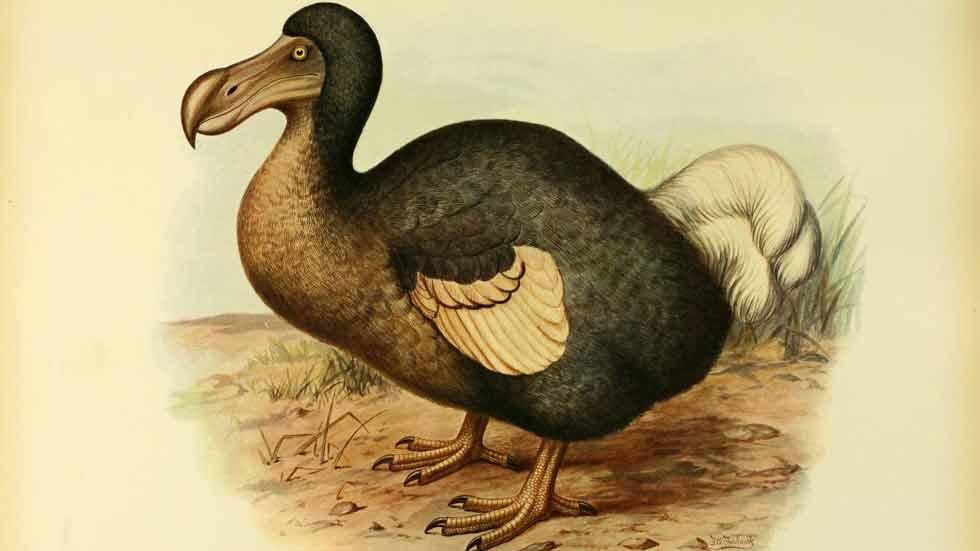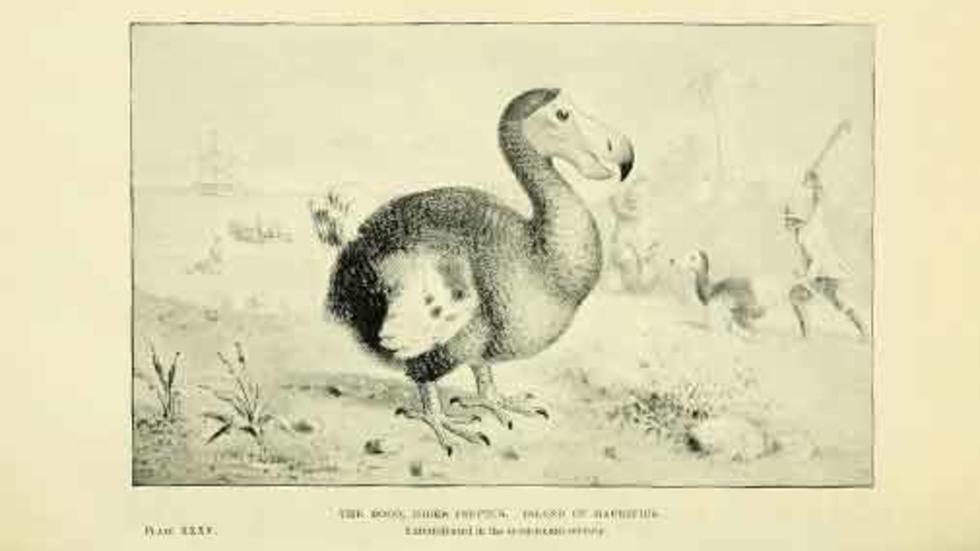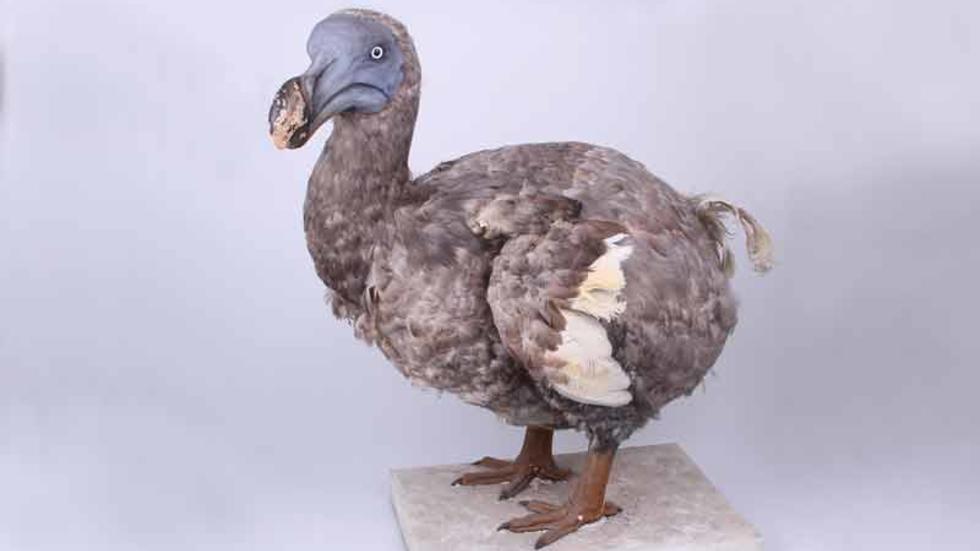Dodo
Introduction
“His call is like that of a gosling…They lay one egg white, as large as a penny bun…on a nest of grass, which they collect, they make their nest in the woods….”
—François Cauche, 1651 (visited Mauritius 1638)
 “Landscape with Birds” (1628) by Roelandt Savery. The Dodo can be seen at the bottom right of this somewhat fanciful scene. Biodiversity Heritage Library. | In 1598, when a Dutch ship arrived on the island of Mauritius in the Indian Ocean, its sailors found a paradise clothed in a dense forest of ebony and bamboo and filled with bewildering wildlife. Many of the animals there were found nowhere else in the world, including a large flightless bird that would eventually be called the Dodo. One hundred years after its discovery the Dodo had vanished making it the first documented case of extinction caused solely by human interference. Because Mauritius is a volcanic island and was never attached to the mainland, it had no mammals other than bats that had flown there. With no natural predators, the Dodo’s ancestors lost their ability to fly, adopted a ground-nesting habit, and became larger. Seventeenth-century observers commented on its diet of seeds, fruit, and probably tree roots. |
Scientific Name
"We called these birds Walghvogels [in English nauseous bird] partly because although we stewed them for a long time, they were very tough to eat.”
—Eyewitness accounts from Admiral Van Neck’s voyage, 1600–1601
 Image of a Dodo by Carolus Clusius, based on eyewitness sketches by Dutch seamen on Admiral van Neck’s voyage, in Atrebatis Exoticorum libri dedcem, a survey of ‘exotic’ animals and plants, published in 1605. Credit: Biodiversity Heritage Library. | Today, the Dodo’s scientific name is referred to as Raphus cucullatus, but this was not always the case. The Dodo’s scientific name has changed several times as ideas of its evolutionary relationships have shifted. The first official name given to the unique bird was Cygnus cucullatus by Juan Eusebio Nieremberg in 1635. Cucullatus means "hooded," and was used in reference to the drawing of the Dodo by the Dutch botanist Carolus Clusius. The use of the genus, Cygnus, presumably reflects Nieremberg’s idea that the Dodo was related to swans. In 1758 the Dodo was renamed as Struthio cucullatus in the 10th edition of Systema Naturae by Linneaus; Struthio is Latin for "ostrich." Two years later, in 1760, the genus was renamed again to Raphus cucullatus by Mathurin Jacques Brisson, most likely in reference to the name Raphos used to describe "the bustard," by Greek physician Galenus. In 1766, the Dodo was renamed once again to Didus ineptus in the 12th edition of Systema Naturae. Despite the inherent appeal of a name that meant “inept Dodo,” the Dodo officially became Raphus cucullatus because of prior naming rules. |
Did you know? The history of the name gives clues to possible close relatives of the Dodo. Molecular research has shown that the Dodo’s ancestors were pigeons from Southeast Asia or Indonesia that arrived on Mauritius probably not long after this volcanic island was formed, about 8 million years ago.
Common Name
There is considerable confusion about the origin of the English common name “Dodo.” In the seventeenth century there were a variety of names used in publications about Mauritius, mostly from Dutch accounts. Although the Portuguese had discovered Mauritius in 1507, they did not publish any materials as they considered their trade routes to be state secrets. However, the Dutch published descriptions of their voyages that were widely translated and generated great interest.
Here are a few common names used in the seventeenth century, with their earliest use dates:
- Doudo, 1500s, from Portuguese for “foolish” or “stupid”
- Dodoor, 1600s, from Dutch for “sluggard”
- Walghvögel, 1601, from Dutch for “nauseous bird” or “disgusting bird”
- Dronte, 1602, from Dutch for “swollen.” Dodaar (& variants), 1626, from Dutch word "aers" (ass) e.g. dodaersen “fat behind”
- Dodo, 1634, from Thomas Herbert’s book Relation of Some Years of Travels into Afrique and the Greater Asia, which he attributed to the Portuguese word, but is more likely to be derived from the Dutch.
Clearly, with these endearing names, the Dodo was destined to be appreciated and preserved.
A Symbol of Extinction
"The dodo was (perverse distinction) immortalized by his extinction."
—Edward Lucie-Smith, 1970, Six More Beasts
 Illustration of a Dodo. Credit: Extinct birds. London: Hutchinson, 1907. Biodiversity Heritage Library. | The Dodo’s flightless nature made it vulnerable once humans arrived. It was easily hunted by European sailors and colonists who also began to cut down its forest home. Even more devastating were the effects of the non-native animals brought to the island. The pigs, cats, dogs, rats, and crab-eating macaques that arrived underwent a spectacular population explosion in an environment devoid of other mammals. Roaming dogs killed adult Dodos, while the rats, monkeys, and cats preyed on eggs and chicks. By the middle of the 1600s Dodos were extremely rare and the species was almost certainly extinct before 1700. The date of the last sighting is disputed. For a long time, the date was thought to be 1681, from the account of sailor and scientist Benjamin Harry. Yet many commentators now think Harry may have been referring to another flightless bird, the Mauritian red rail, and the Dodo went extinct earlier. |
What Did the Dodo Look Like?
Contemporary descriptions and illustrations of the Dodo are often contradictory. The earliest drawings, including those in the first written account of Mauritius by Admiral van Neck, show slim birds. However, the artist Roelandt Savery (1576–1639), who produced many Dodo paintings, shows a fatter, more ungainly animal. This is closer to popular understanding of its appearance, typified in the Rowland Ward model commonly seen in museums, and, of course, from the original illustrations in Lewis Carroll’s Alice’s Adventures in Wonderland.
 A newer, slimmer Dodo model at the Oxford University Museum of Natural History. Credit: Ballista, Wikipedia. CC BY-SA 3.0 |  Original illustration (1865) by John Tenniel from Alice’s Adventures in Wonderland. Public Domain |  Illustration of the Dodo. Credit: Verzameling van uitlandsche en zeldzaame vogelen. Amsterdam:J.C. Sepp,1772-1781. Biodiversity Heritage Library. Public Domain |
Research based on analysis of sub-fossil bones, however, suggests that the Dodo was probably much thinner and more athletic than is commonly depicted. It is possible that over-stuffed taxidermy specimens were the inspiration for many illustrations.
Did you know? The descriptions of the Dodo by early sailors, who had been at sea for many months, focused on the facet most important to them: what they tasted like. Most descriptions were unfavorable but the Dodo made up for being a culinary disappointment in one regard—it was extremely easy to catch.
Learn More
Browse
Encyclopedia of Life Dodo web page
Dodo Images from the Biodiversity Heritage Library
Read
Hugh Strickland “Dodo and Kindred Birds” (1848) includes an exhaustive list of Dodo names
A short paper on the story of our changing understanding of the Dodo’s appearance
The story of the Oxford Dodo, the most complete remains of the bird from the seventeenth century
Watch
Two short videos by paleontologist and artist Julian Pender Hume describing the world of the Dodo and painting a "slimmer" Dodo. Credit: Natural History Museum, London.
Slideshow Image Credits
Frederick William Frohawk's restoration of Raphus cucullatus from Extinct birds London: Hutchinson,1907. Biodiversity Heritage Library; Dodo Restoration. The human side of birds. New York, Frederick A. Stokes company[c1917]. Rowland Ward model of a Dodo. Museum of Comparative Zoology, Harvard University © President and Fellows of Harvard College




